Advertisements
Online Mock Tests
Chapters
▶ 2: Current Electricity
3: Magnetism and magnetic effects of electric current
4: Electromagnetic Induction And Alternating Current
5: Electromagnetic waves
6: Ray Optics
7: Wave Optics
8: Dual Nature of Radiation and Matter
9: Atomic and Nuclear physics
10: Electronics and Communication
11: Recent Developments in Physics
![Samacheer Kalvi solutions for Physics - Volume 1 and 2 [English] Class 12 TN Board chapter 2 - Current Electricity Samacheer Kalvi solutions for Physics - Volume 1 and 2 [English] Class 12 TN Board chapter 2 - Current Electricity - Shaalaa.com](/images/physics-volume-1-and-2-english-class-12-tn-board_6:5f2b1b2038084cf381bfa42c826a928c.jpg)
Advertisements
Solutions for Chapter 2: Current Electricity
Below listed, you can find solutions for Chapter 2 of Tamil Nadu Board of Secondary Education Samacheer Kalvi for Physics - Volume 1 and 2 [English] Class 12 TN Board.
Samacheer Kalvi solutions for Physics - Volume 1 and 2 [English] Class 12 TN Board 2 Current Electricity Evaluation [Pages 118 - 123]
Multiple Choice Questions
The following graph shows current versus voltage values of some unknown conductor. What is the resistance of this conductor?
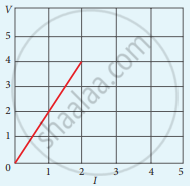
2 ohm
4 ohm
8 ohm
1 ohm
A wire of resistance 2 ohms per meter is bent to form a circle of radius 1m. The equivalent resistance between its two diametrically opposite points, A and B as shown in the figure is

π Ω
`π/2` Ω
2 π Ω
`π/4` Ω
A toaster operating at 240 V has a resistance of 120 Ω. Its power is ______.
400 W
2 W
480 W
240 W
A carbon resistor of (47 ± 4.7 ) k Ω to be marked with rings of different colours for its identification. The colour code sequence will be ______.
Yellow – Green – Violet – Gold
Yellow – Violet – Orange – Silver
Violet – Yellow – Orange – Silver
Green – Orange – Violet - Gold
What is the value of resistance of the following resistor?

100 k Ω
10 k Ω
1 k Ω
1000 k Ω
Two wires of A and B with circular cross-section are made up of the same material with equal lengths. Suppose RA = 3RB, then what is the ratio of radius of wire A to that of B?
3
`sqrt3`
`1/sqrt3`
`1/3`
A wire connected to a power supply of 230 V has power dissipation P1. Suppose the wire is cut into two equal pieces and connected parallel to the same power supply. In this case, power dissipation is P2. The ratio of `"P"_2/"P"_1` is
1
2
3
4
In India electricity is supplied for domestic use at 220 V. It is supplied at 110 V in USA. If the resistance of a 60W bulb for use in India is R, the resistance of a 60W bulb for use in USA will be
R
2R
`"R"/4`
`"R"/2`
In a large building, there are 15 bulbs of 40 W, 5 bulbs of 100 W, 5 fans of 80 W, and 1 heater of 1 kW are connected. The voltage of electric mains is 220 V. The minimum capacity of the main fuse of the building will be
14 A
8 A
10 A
12 A
There is a current of 1.0 A in the circuit shown below. What is the resistance of P?

1.5 Ω
2.5 Ω
3.5 Ω
4.5 Ω
What is the current out of the battery?
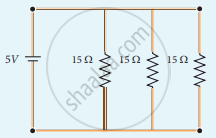
1A
2A
3A
4A
The temperature deficient of resistance of a wire is 0.00125 per°C At 20°C, its resistance is 1Ω. The resistance of the wire will be 2Ω at
800°C
700°C
850°C
820°C
The internal resistance of a 2.1 V cell which gives a current of 0.2 A through a resistance of 10Ω is ______.
0.2 Ω
0.5 Ω
0.8 Ω
1.0 Ω
A piece of copper and another of germanium are cooled from room temperature to 80 K. The resistance of ______.
each of them increases
each of them decreases
copper increases and germanium decreases
copper decreases and germanium increases
In Joule’s heating law, when I and t are constant, if the H is taken along the y axis and I2 along the x axis, the graph is ______.
straight line
parabola
circle
ellipse
Short Answer Questions
Why current is a scalar?
Define Current density.
Distinguish between drift velocity and mobility.
State microscopic form of Ohm’s law.
State macroscopic form of Ohm’s law.
What is ohmic device?
What is non ohmic device?
Define electrical resistivity.
Define temperature coefficient of resistance.
Write a short note on superconductors?
What is electric power?
What is electric energy?
Derive the expression for power P = VI in electrical circuit.
Write down the various forms of expression for power in electrical circuit.
State Kirchhoff’s current rule.
State Kirchhoff ’s voltage rule.
State the principle of potentiometer.
What do you mean by internal resistance of a cell?
State Joule’s law of heating.
What is Seebeck effect?
What is Thomson effect?
What is Peltier effect?
State the applications of Seebeck effect.
Long Answer Questions
Describe the microscopic model of current and obtain general form of Ohm’s law.
Obtain the macroscopic form of Ohm’s law from its microscopic form and discuss its limitation.
Explain the equivalent resistance of a series resistor network.
Explain the equivalent resistance of a parallel resistor network.
Explain the determination of the internal resistance of a cell using voltmeter.
State and explain Kirchhoff’s rules.
Obtain the condition for bridge balance in Wheatstone’s bridge.
Explain the determination of unknown resistance using meter bridge.
How the emf of two cells are compared using potentiometer?
Numerical problems
The following graphs represent the current versus voltage and voltage versus current for the six conductors A, B, C, D, E and F. Which conductor has least resistance and which has maximum resistance?

Lightning is a very good example of a natural current. In typical lightning, there is 109 J energy transfer across the potential difference of 5 × 107 V during a time interval of 0.2 s. Using this information, estimate the following quantities:
- the total amount of charge transferred between cloud and ground
- the current in the lightning bolt
- the power delivered in 0.2 s.

A copper wire of 10-6 m2 area of cross-section, carries a current of 2 A. If the number of electrons per cubic meter is 8 × 1028, calculate the current density and average drift velocity.
The resistance of a nichrome wire at 0°C is 10Ω. If its temperature coefficient of resistivity of nichrome is 0.004/ °C, find its resistance of the wire at boiling point of water. Comment on the result.
The rod given in the figure is made up of two different materials.

Both have square cross-sections of 3 mm side. The resistivity of the first material is 4 x 10-3 Ω.m and it is 25 cm long while the second material has a resistivity of 5 x 10-3 Ω.m and is of 70 cm long. What is the resistivity of rod between its ends?
Three identical lamps each having a resistance R are connected to the battery of emf as shown in the figure.
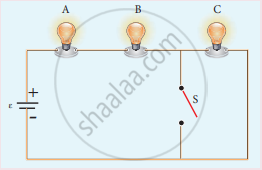
Suddenly the switch S is closed.
- Calculate the current in the circuit when S is open and closed.
- What happens to the intensities of the bulbs A, B and C.
- Calculate the voltage across the three bulbs when S is open and closed.
- Calculate the power delivered to the circuit when S is opened and closed.
- Does the power delivered to the circuit decrease, increase or remain same?
An electronics hobbyist is building a radio which requires 150 Ω in her circuit, but she has only 220 Ω, 79 Ω, and 92 Ω resistors available. How can she connect the available resistors to get the desired value of resistance?
A cell supplies a current of 0.9 A through a 2 Ω resistor and a current of 0.3 A through a 7 Ω resistor. Calculate the internal resistance of the cell.
Calculate the currents in the following circuit.
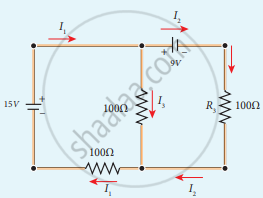
A potentiometer wire has a length of 4 m and resistance of 20 Ω. It is connected in series with resistance of 2980 Ω and a cell of emf 4 V. Calculate the potential along the wire.
Determine the current flowing through the galvanometer (G) as shown in the figure.
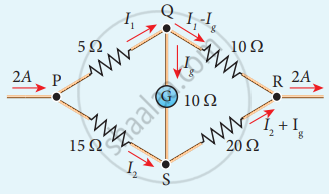
Two cells each of 5V are connected in series across an 8Ω resistor and three parallel resistors of 4Ω, 6Ω, and 12Ω. Draw a circuit diagram for the above arrangement. Calculate
- the current drawn from the cell
- current through each resistor
Four light bulbs P, Q, R, S are connected in a circuit of unknown arrangement. When each bulb is removed one at a time and replaced, the following behavior is observed.
| P | Q | R | S | |
| P removed | * | on | on | on |
| Q removed | on | * | on | off |
| R removed | off | off | * | off |
| S removed | on | off | on | * |
Draw the circuit diagram for these bulbs.
In a potentiometer arrangement, a cell of emf 1.25 V gives a balance point at 35 cm length of the wire. If the cell is replaced by another cell and the balance point shifts to 63 cm, what is the emf of the second cell?
Solutions for 2: Current Electricity
![Samacheer Kalvi solutions for Physics - Volume 1 and 2 [English] Class 12 TN Board chapter 2 - Current Electricity Samacheer Kalvi solutions for Physics - Volume 1 and 2 [English] Class 12 TN Board chapter 2 - Current Electricity - Shaalaa.com](/images/physics-volume-1-and-2-english-class-12-tn-board_6:5f2b1b2038084cf381bfa42c826a928c.jpg)
Samacheer Kalvi solutions for Physics - Volume 1 and 2 [English] Class 12 TN Board chapter 2 - Current Electricity
Shaalaa.com has the Tamil Nadu Board of Secondary Education Mathematics Physics - Volume 1 and 2 [English] Class 12 TN Board Tamil Nadu Board of Secondary Education solutions in a manner that help students grasp basic concepts better and faster. The detailed, step-by-step solutions will help you understand the concepts better and clarify any confusion. Samacheer Kalvi solutions for Mathematics Physics - Volume 1 and 2 [English] Class 12 TN Board Tamil Nadu Board of Secondary Education 2 (Current Electricity) include all questions with answers and detailed explanations. This will clear students' doubts about questions and improve their application skills while preparing for board exams.
Further, we at Shaalaa.com provide such solutions so students can prepare for written exams. Samacheer Kalvi textbook solutions can be a core help for self-study and provide excellent self-help guidance for students.
Concepts covered in Physics - Volume 1 and 2 [English] Class 12 TN Board chapter 2 Current Electricity are Ohm's Law (V = IR), Energy and Power in Electrical Circuits, Electric Cells and Batteries, Kirchhoff’s Rules, Heating Effect of Electric Current, Thermoelectric Effect, Electric Current.
Using Samacheer Kalvi Physics - Volume 1 and 2 [English] Class 12 TN Board solutions Current Electricity exercise by students is an easy way to prepare for the exams, as they involve solutions arranged chapter-wise and also page-wise. The questions involved in Samacheer Kalvi Solutions are essential questions that can be asked in the final exam. Maximum Tamil Nadu Board of Secondary Education Physics - Volume 1 and 2 [English] Class 12 TN Board students prefer Samacheer Kalvi Textbook Solutions to score more in exams.
Get the free view of Chapter 2, Current Electricity Physics - Volume 1 and 2 [English] Class 12 TN Board additional questions for Mathematics Physics - Volume 1 and 2 [English] Class 12 TN Board Tamil Nadu Board of Secondary Education, and you can use Shaalaa.com to keep it handy for your exam preparation.
